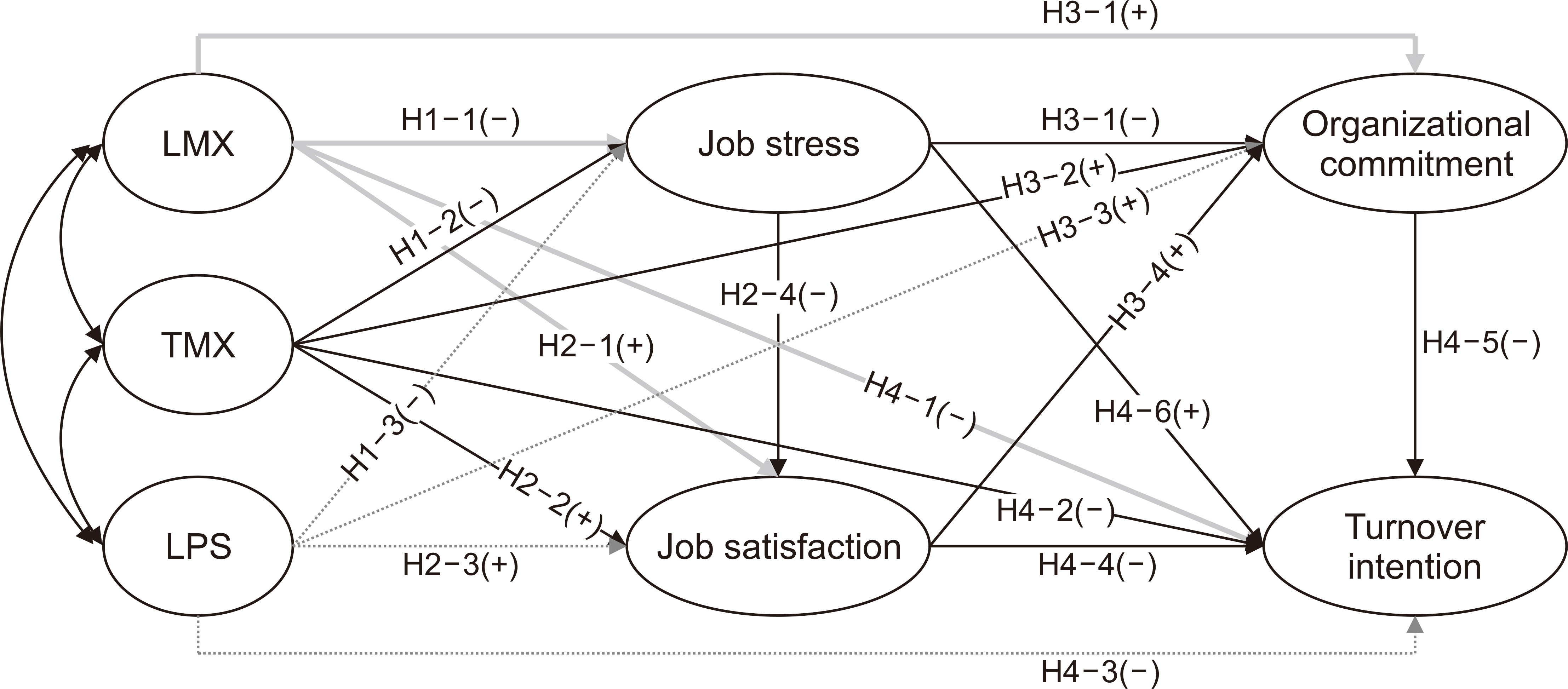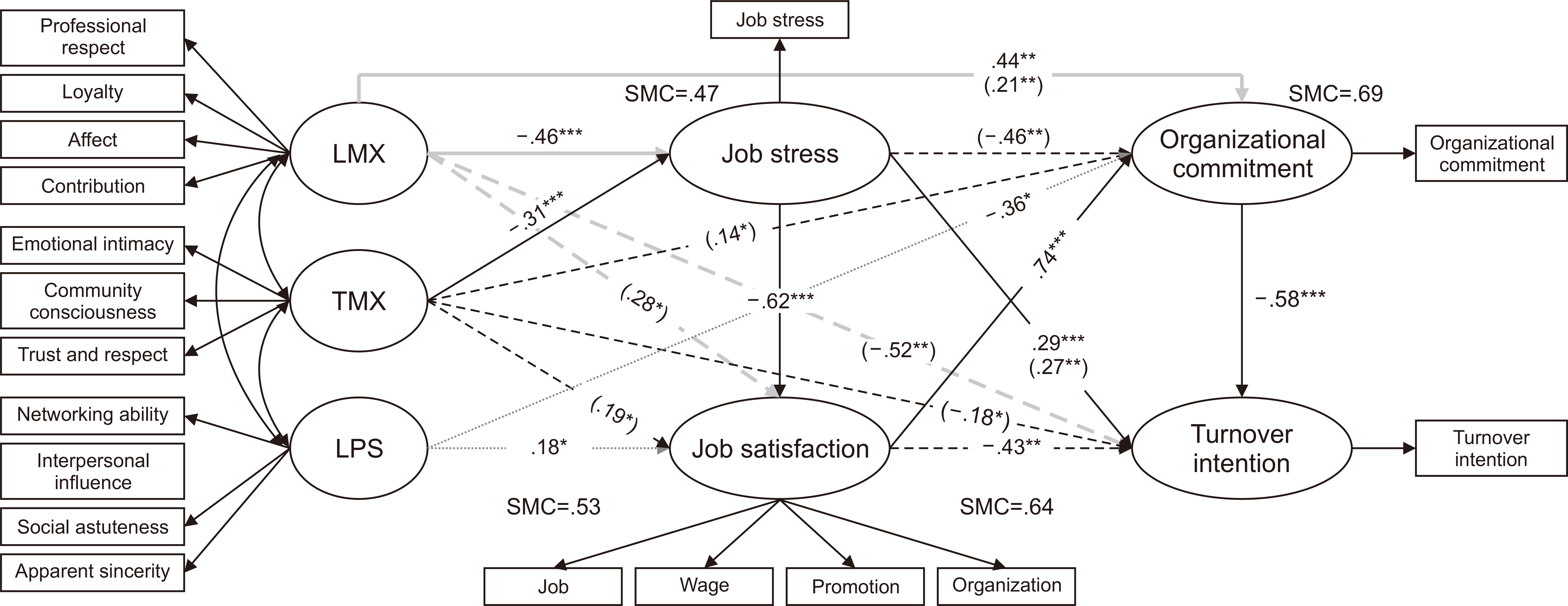J Korean Acad Oral Health.
2021 Jun;45(2):92-99. 10.11149/jkaoh.2021.45.2.92.
Analysis of the factors of turnover intention of dental hygienists in dental hospitals
- Affiliations
-
- 1Department of Biomedical Health Science, Graduate School, Dong-Eui University, Busan, Korea
- 2Oral Hygiene Science Research Institute, Dong-Eui University, Busan, Korea
- 3Department of Dental Hygiene, Dong-Eui University, Busan, Korea
- 4Department of Dental Hygiene, Masan University, Changwon, Korea
- KMID: 2517235
- DOI: http://doi.org/10.11149/jkaoh.2021.45.2.92
Abstract
Objectives
This study aims to determine the influence of social exchange relationships, leader’s political skills, job stress, job satisfaction, and organizational commitment on turnover intention among dental hospital hygienists.
Methods
A self-administrated questionnaire survey was conducted from April 1-May 12, 2020, involving 209 dental hospital hygienists in Seoul, Busan, and Gyeongnam. The collected data were analyzed using SPSS and AMOS statistical analysis programs.
Results
In the hypotheses testing, 9 of 18 hypotheses were supported. In social exchange relationships, job stress, job satisfaction, and organizational commitment, the path to turnover intention had a significant effect, but it was not statistically significant in leader’s political skills. With regard to mediating effect, job stress, job satisfaction, and organizational commitment played a complete mediating role in the path from social exchange relationships to turnover intention.
Conclusions
To increase job satisfaction and organizational commitment, and lower job stress in order to have a positive impact on turnover intentions, it is imperative to develop and apply a program to enhance social exchange relationships.
Keyword
Figure
Reference
-
References
1. Kim YW, Shin SY. 2019; Exploring Antecedent Factor that Influence Dental Hygienist's Job Satisfaction and Turnover Intention. J the Korea Academ ia- Industrial cooperation Society. 20:329–337.2. Kwon JY, Lee SY. 2016; Relationship of between Task Performance, Job Satisfaction, and Organizational Contribution of Dental Hygienists. J Den Hyg Sci. 16:302–309. DOI: 10.17135/jdhs.2016.16.4.302.
Article3. Han JY, Cho JY. 2018; The Effect of Organizational Social Capital on Job Stress, Job Satisfaction and Turnover Intention :. Focusing on Dental Hygienists Korean Management Consulting Review. 18:187–95.4. Ministry of Health and Welfare Press Release Improving the supply and demand of manpower and working environment by implementing the Health and Medical Manpower Support Act. 2019[internet]. http://www.mohw.go.kr/react/al/sal0301vw.jsp?PAR_MENU_ID=04&MENU_ID=0403&CONT_SEQ=351289. cited2019Oct 24.5. Korea Employment Information Service. Korea network for occupations and workers.2017[Internet].6. Ji MG. 2016; The Effect of Turnover Intention on the Job Stress, Burn out and Organizational Commitment - Focused on New Dental Hygienists -. Korea EntertaInment Industry Association. 10:379–387. http://www.keis.or.kr/user/extra/main/2102/publication/publicationList/jsp/LayOutPage.do?categoryIdx=131&pubIdx=5188&onlyList=N. DOI: 10.21184/jkeia.2016.12.10.6.379.
Article7. Han SY, Cho YC. 2016; Covariance Structure Analysis on the Impact of Job Stress, Fatigue Symptoms and Job Satisfaction on Turnover Intention among Dental Hygienists. J Korea Academia-Industrial cooperation Society. 17:629–640. DOI: 10.5762/KAIS.2016.17.7.629.
Article8. Kang KN. 2018. Structural Equation modeling of nurses' turnover Intention based on Social Exchange(LMX-TMX), Positive Psychological Capital and Organizational commitment : Focused on Tertiary and General Hospitals [Doctor's thesis]. Univ of Korea;Seoul: [Korean].9. Banks GC, Batchelor JH, Seers A, O'Boyle EH, Pollack JM, Gower K. 2014; What does team-member exchange bring to the party? A meta analytic review of team and leader social exchange. J Organ Behav. 35:273–295. DOI: 10.1002/job.1885.10. Seers A. 1989; Team-member exchange quality: A new construct for role- making research. Organ Behav Hum Decis Process. 43:118–35. DOI: 10.1016/0749-5978(89)90060-5.11. Mintzberg H. 1985; The organization as political arena. J Manag Stud. 22:133–54. DOI: 10.1111/j.1467-6486.1985.tb00069.x.
Article12. Park JI, Kim SG. 2014; The Effects of Emotional Leadership of Director of a Day Care Center on LMX (Leader-Member Exchange) and TMX (Team -Member Exchange). Korean J Family Welfare. 19:929–946. DOI: 10.13049/kfwa.2014.19.4.929.13. Yoon NN, Lee JY, Yu BC. 2017; The correlations between psychological empowerment, leader-member exchange (LMX) and job satisfaction in dental hygienists. J Korean Soc Dent Hyg. 17:405–418. DOI: 10.13065/jksdh.2017.17.03.405.
Article14. Kang KS, Song RH. 2012; The Relationship among Principal' s Emotional Leadership, LMX(Leader-Member Exchange),TMX(Team-Member Exchange), CMX(Custom er- Member Exchange), and School Organizational Effectiveness. J Educational Administration. 30:471–498.15. Dierdorff EC, Bell ST, Belohlav JA. 2011; The power of "we": effects of psy cholog ical collectivism on team performance over time. J Appl Psychol. 96:247–262. DOI: 10.1037/a0020929. PMID: 20919792.16. Kim MY, Lee CK. 2019; The effect of political skill of airline cabin crew leader on team performance: the mediating role of team-member exchange. J Hospitality and Tourism Studies. 21:257–270. DOI: 10.31667/jhts.2019.6.79.257.
Article17. Noh EM, Jeon ES, Ko HJ. 2015; The Effects of Dental Hygienists' LMX (Leader-Member Exchange) and Empowerment on Organizational. Perfo rman ce J Den Hyg Sci. 15:650–658. DOI: 10.17135/jdhs.2015.15.5.650.18. Chou HY, Hecker R, Martin A. 2012; Predicting nurses' well-being from job demands and resources: A cross-sectional study of emotional labour. J Nurs Manag. 20:502–511. DOI: 10.1111/j.1365-2834.2011.01305.x. PMID: 22591152.
Article19. Yu JP. 2010. Structural equation models: Concepts and understanding. Hannarae Publishing Company;Seoul: p. 1–567.20. Dienesch RM, Liden RC. 1986; Leader-member exchange model of leadership ;A Critique and Further Development. Acad Manag Revt. 11:618–34. DOI: 10.5465/amr.1986.4306242.
Article21. Kim RA, Kim IH. 2004; A Study on Relationship among Quality of LMX, Self-Concept and Organizational Effectiveness. Korean Academy of orga nization and Management. 28:171–213.22. Seok BI, Han MS. 2014; Effect of Leader-member Exchange on the Job Satisfaction and Organizational Commitment: Focusing on Team Work. Academic Society of Global Business Administration. 13:155–178. DOI: 10.38115/asgba.2016.13.2.155.
Article23. Nielsen IK, Jex SM, Adams GA. 2000; Development and validation of scores on a two-dimensional workplace friendship. Educ Psychol Meas. 60:628–43. DOI: 10.1177/00131640021970655.24. Bedi A, Skowronski M. 2014; Political skill at work: good or bad Understand ing its predictors and consequences. SAM Advanced Management Journal. 79:39–47.25. Kang KG, Kim JH. 2015; The Effects of Political Skill on Department Effectiveness : The Mediating Role of Leadership Effectiveness. Korea J Business Administration. 28:1277–1302.26. Chang SJ, Koh SB, Kang DM, Kim SA, Kang MG, Lee CG, et al. 2005; Developing an Occupational Stress Scale for Korean Employees. Korean J Occup Environ Med. 17:297–317. DOI: 10.35371/kjoem.2005.17.4.297.
Article27. Smith PC, Kendall LM, Hulin CL. 1969. The measurement of Satisfaction in work and Retirement; A Strategy for the Study of Attitudes. Rand McNally and Company;Chicago: p. 169–176.28. Yang IS, Myung MS, Lee SJ, Lee HY. 2004; The relationship between job satisfaction and intention to quit of employees in F&B department of hotels by job type. Korean J Soc Food Cookery Sci. 20:151–157.29. Mowday RT, Steer RM, Porter LW. 1979; The measurement of organization commitment. J Vocat Behav. 14:224–247. DOI: 10.1016/0001-8791(79)90072-1.30. Kim YJ, Han KS. 2015; Relationships among Emotional Leadership, Commitment, Patient Orientation, and Job Performance in Dental Hygienists. J Korean Soc Dent Hyg. 15:551–559. DOI: 10.17135/jdhs.2015.15.5.551.
Article31. Mobley WH. 1982; Employee turnover: Causes, consequences and control. Menlo park, CA:. Addison Wesley. 36:506. DOI: 10.2307/2523037.32. Moon SJ, Han SS. 2011; A Predictive Model on Turnover Intention of Nurses in Korea. J Korean Acad Nurs. 41:633–641. DOI: 10.4040/jkan.2011.41.5.633. PMID: 22143212.
Article33. Thomas CH, Lankau MJ. 2009; Preventing burnout: The effects of LMX and mentoring on socialization, role stress, and burnout. Human Resource Management: Published in Cooperation with the School of Business Administration. The University of Michigan and in Alliance with the Society of Human Resources Management. 48:417–432. DOI: 10.1002/hrm.20288.34. Lee KH, Shin IY. 2016; A Multilevel Approach to the Relationship between Leader-Member Exchange and Team Members Job Stress. Korea Business Review. 45:687–710. DOI: 10.17287/kmr.2016.45.2.687.
Article35. Seers A, Petty M.M, Cashman JF. 1995; Team-member exchange under team and traditional management. Group Organ Manage. 20:18–38. DOI: 10.1177/1059601195201003.
Article36. Ahearn KK, Ferris GR, Hochwarter WA, Douglas C, Ammeter AP. 2004; Leader Political Skill and Team Performance. J Manag. 30:309–327. DOI: 10.1016/j.jm.2003.01.004.
Article37. Hwang JH, Chin ST. 2014; The Relationship among LMX, TMX, Organizational Commitment and Organizational Citizenship Behavior of Sports Center Instructor. J Sport Physiological. 23:127–138.38. Munyon TP, Summers JK, Thompson KM, Ferris GR. 2015; Political skill and work outcomes: A theoretical extension, meta-analytic investigation and agenda for the future. Personnel Psychology. 68:143–184. DOI: 10.1111/peps.12066.
Article39. Ferris GR, Treadway DC, Perrewé PL, Brouer RL, Douglas C, Lux S. 2007; Political Skill in Organizations. J Manag. 33:290–320. DOI: 10.1177/0149206307300813.
Article
- Full Text Links
- Actions
-
Cited
- CITED
-
- Close
- Share
- Similar articles
-
- The Influence of Job Stress and Job Satisfaction on Turnover Intention for Male Dental Hygienists
- Influence of Job Embeddedness and Resilience on Turnover Intention in Dental Hygienists
- Factors Affecting the Turnover Intention of Dental Hygienists: Emotional Labor, Job Satisfaction, and Social Support
- The Effect of Clinical Dental Hygienist’s Moral Sensitivity and Psychological Well-Being on Job Engagement
- Structural model on factors influencing career withdrawal intention of dental hygienists



